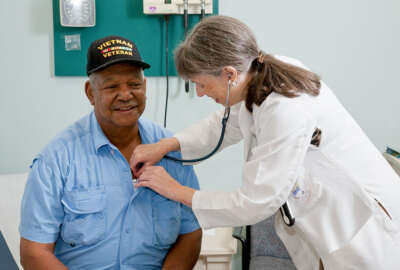

After struggling to fill tens of thousands of vacancies for years, the Veterans Health Administration has hired more than 23,000 new employees in three-to-four...
The Veterans Health Administration has continued its hiring spree well into the summer, with 23,000 new employees now on board since the pandemic’s beginning in March.
Thanks to a new, shortened onboarding process, the agency saw a net increase of 8,000 new employees so far this fiscal year, with two-thirds of those new hires occurring since the end of March, VHA officials told Congress this week.
Before the pandemic, VHA’s average time-to-hire was about 94 days. But during the health crisis, the agency has been hiring and onboarding within 10-to-12 days.
In some cases, new hires are starting work within three days, Steven Lieberman, VA’s acting principal deputy undersecretary for health, told the Senate Veterans Affairs Committee Wednesday afternoon.
VHA has been able to drastically cut down the time-to-hire by delaying certain reference checks and other onboarding activities until after a new hire begins work. The agency has cut some steps out of the hiring process altogether.
Congress is largely pleased, if not slightly exasperated, by VA’s recent hiring successes. The department has consistently tracked 40,000-to-50,000 vacancies across the system for the past few years, and Congress, which has authorized direct-hire flexibilities in past legislation, has been disappointed VA didn’t use those authorities sooner.
“It shouldn’t take a pandemic for the VA to be able to fix some of its internal hiring processes, when many of the changes, I think, could have been made years ago,” Jon Tester (D-Mont.), ranking member of the Senate Veterans Affairs Committee, said. “Some of these authorities are several years old, and the VA has yet to put them to use.”
Beyond the procedural changes, a national hiring campaign also helped reach new talent. The agency is also hopeful the public will see VHA as an attractive, reliable employer, especially as many private sector health organizations have laid off staff in recent months, Jessica Bonjorni, VHA’s chief of human capital management, told senators.
Still, both VA and Congress are eager to make some of the recent hiring and onboarding changes perennial fixtures in the department. Some may need legislative or regulatory fixes to make permanent.
“We’re still just three months into this process, and so we will be paying close attention to this, making sure there are no unintended consequences to some of these improvements we’ve made,” Lieberman said. “We certainly are prepared to come back if we need any support from the committee. We’re just not ready to ask for that today.”
VHA is still assessing whether the risk it took on to hire new employees without the full range of usual records checks is paying off.
“We have not seen untoward events in occurring in our health care system to date. We also have not had to remove any clinical staff that we’ve hired under this expedited process,” Lieberman said. “We do check three items right up front. We make sure they have an active license and we check a reference. [We also] go to the National Practitioner Database. There we can see if an applicant had a payment with a malpractice suit, if they have a history of criminal activity or civil action against them related to healthcare, whether they’ve been denied an appointment to a health care program, state or federal.”
If VA sees any warning signs during or after the onboarding process, the department will pull those medical professionals from patient care.
Tester said he was concerned current VA employees were feeling supported, especially during the pandemic. A safe and engaged workforce goes a long way toward recruiting new talent, he said.
“The first people you would talk to, either before the interview or after, would be the people who work in that facility,” he said. “If they’re not happy we’re not going to get the employees we need. Quite frankly, we have great employees within the VA. We just need more of them, and we need to retain the good ones we have.”
To employees engaged throughout the pandemic, Veterans Integrated Service Network (VISN) leaders are offering special contribution and retention awards to employees. VHA is also waiving the typical biweekly and annual pay caps for employees directly working on the frontlines of the pandemic, thanks to a waiver Congress included in the Coronavirus Aid, Relief and Economic Security (CARES) Act.
At least 150 employees had exceeded their biweekly pay caps during a month-long period from mid-April through mid-May, Bonjorni said. She anticipated more employees would exceed pay and overtime caps as VA’s response efforts continue for the rest of the year.
More than 2,000 employees volunteered to temporarily deploy to other VA facilities and state-run veterans’ nursing homes where the demand for extra help was especially high.
As the caseload grows, VHA said it was mindful of employee burnout during the pandemic. Absenteeism rates have remained steady this year compared to previous years, VA said.
The department has been tracking a total of 23,359 coronavirus cases among veterans, employees and civilian patients since the start of the pandemic. Today, the department has 4,483 active cases, including 400 VHA employees, according to public data.
Victoria Brahm, VISN 12 director, said medical centers in her region have created spaces where employees can unwind and relax. Her mental health experts have identified and are sharing resources with the workforce, and some have hosted listening sessions where employees can vent.
“I am shocked. We have very little call-offs during a pandemic that is very scary. We’ve had people come back who were retired. I had a nurse who came back after retiring after 40 years of service,” she said. “She came right back into an epidemic and helped do infection control surveillance. I have a retired respiratory therapist who came back to activate a medical hospital on one of my hospital campuses.”
With help from the Office of Personnel Management, VA has hired back some retired employees as reemployed annuitants.
“They’re just awesome,” Brahm said of the employees. “Every day I’m amazed by the resilience.”
Copyright © 2025 Federal News Network. All rights reserved. This website is not intended for users located within the European Economic Area.
Nicole Ogrysko is a reporter for Federal News Network focusing on the federal workforce and federal pay and benefits.
Follow @nogryskoWFED



